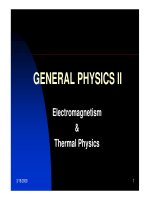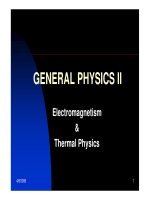- Trang chủ >>
- Khoa Học Tự Nhiên >>
- Vật lý
Tài liệu Chapter XIII Electromagnetic Oscilation, Eletromagnetic Field and Wave doc
Bạn đang xem bản rút gọn của tài liệu. Xem và tải ngay bản đầy đủ của tài liệu tại đây (691.31 KB, 49 trang )
4/8/2008 1
GENERAL PHYSICS II
Electromagnetism
&
Thermal Physics
4/8/2008 2
Chapter XIII
Electromagnetic Oscilation,
Eletromagnetic Field and Wave
§1. Oscillating circuits
§2. System of Maxwell’s equations
§3. Maxwell’s equations and electromagnetic waves
4/8/2008 3
We have known the close connection between changing eletric fields
and magnetic fields. They can create each other and form a system of
electromagnetic fields.
Electromagnetic fields can propagate in the space (vacuum or material
environment). We call them electromagnetic waves. They play a very
important role in science and technology.
In this chapter we will study how can describe electromagnetic fields,
what are their properties (in comparison with mechanical waves).
First we consider the oscillating circuits in which there exist oscillating
currents and voltages. They are sources for electromagnetic fields
4/8/2008 4
§1. Oscillating circuits:
1.1 L-C circuits and electrical oscillations:
• Consider the RC and LC
series circuits shown:
• Suppose that the circuits are
formed at t=0 with the capacitor
charged to value Q.
There is a qualitative difference in the time development of the
currents produced in these two cases. Why??
L
C
C
R
++++
- - - -
++++
- - - -
1.1.1 Consider from point of view of energy (qualitatively):
• In the RC circuit, any current developed will cause energy to be
dissipated in the resistor.
• In the LC circuit, there is NO mechanism for energy dissipation;
energy can be stored both in the capacitor and the inductor!
4/8/2008 5
RC:
current decays exponentially
C
R
0
t
I
0
I
Q
+++
- - -
L
C
LC:
current oscillates
I
0
0
t
I
Q
+++
- - -
4/8/2008 6
Recall: Energy in the Electric and Magnetic Fields
2
1
2
U LI
2
magnetic
0
1
2
B
u
… energy density ...
Energy stored in an inductor ….
B
Energy stored in a capacitor ...
2
1
2
U C V
2
electric 0
1
2
u E
… energy density ...
+++ +++
- - - - - -
E
4/8/2008 7
L
C
+ +
-
-
0I
0
QQ
L
C
+
+
-
-
0I
0
QQ
L
C
0
II
0Q
L
C
0
II
0Q
Energy is stored in the capacitor Energy is stored in the inductor
Energy is stored in the capacitorEnergy is stored in the inductor
4/8/2008 8
where
and Q
0
determined from initial conditions
• Differentiate above form for Q(t) and substitute into the differential
equation we can find
L
C
I
1.1.2 Equations for Q(t) and I(t):
2
2
dt
Qd
L
dt
dI
L
C
Q
VV
LC
)cos(
00
tQQ
remember:
0
2
2
d x
m kx
dt
1
2
At t = 0 the switch is transfered from
the position 1 to the position 2:
0
2
2
C
Q
dt
Qd
L
The solution Q(t) has the form analogue
to SHM (simple hamonic motion):
4/8/2008 9
)sin(
000
tQ
dt
dQ
)cos(
00
2
0
2
2
tQ
dt
Qd
0)cos(
1
)cos(
0000
2
0
tQ
C
tQL
0
1
2
0
C
L
Therefore,
LC
1
0
The oscillation of the current in LC circuit is determined by the
following equation:
)sin(
000
tQ
dt
dQ
I
00
QI
m
),sin(
0
tII
m
4/8/2008 10
I
1
2
L
C
R
1.2 LCR circuit and damped oscillation:
dt
dI
LRI
C
Q
VVV
LRC
0
2
2
C
Q
dt
dQ
R
dt
Qd
L
When the swicth is transferred to 2:
The solution Q(t) has the form of a damped oscillation:
where
L
R
2
)'cos(
0
t
βt
eQQ
o
2
2
4
1
L
R
LC
'
o
and
The frequency of oscilation
(In an LRC circuit, depends also on R)
Damping constant
4/8/2008 11
t
0
Q
0
Q
t
1
1
4
0
R
R
0
RR
Some remarks:
• The amplitude of oscillation is damping,
since energy is dissipated in the resistor.
The role of resistance in oscillations of the
current in LCR circuit is analogue to friction
in mechanical oscillations !
• The resistance R increases → the amplitude
of oscillation decreases faster. Oscillations
will occure as long as
’
0
is real, so there
exists a critical resistance
C
L
R
L
R
LC
c
c
4
4
1
2
2
c
RR
c
RR
c
RR
If
the circuit is called underdamped;
: critically damped;
: overdamped.
4/8/2008 12
1.3 LRC circuit with alternating current (AC) source:
This is the case analogue to the mechanical
driven oscillations with a periodic force.
L
C
R
2
2
sin
m
d Q dQ Q
L R t
dt dt C
Suppose that the emf of the source has
the following form:
=
m
sin
t
The equation for Q(t) must be modified
by adding AC emf in the right hand side:
First we consider the particular cases: the circuit
R, or
C,
or
L only.
4/8/2008 13
1.3.1
R Circuit:
I
R
s i n
R R m
V R I t
1
0
0
t
I
R
R
m
R
m
1
0
0
V
R
t
The formulas for the voltage and current
across R are as follows
s i n
m
R
I t
R
t
dt
dQ
R
m
sin
The above equation leads to
m
-
m
4/8/2008 14
• Remark: Both the current and the voltage vary with time as sin
t .
We say they are “in phase” .
Phasor diagram:
• Vectors represent the maximum
voltage and the maximum current
• Both vectors make an angle
t
with the positive x-axis
• With time both vectors rotate
counter-clockwise
• The vertical component of each
vector represents the instantaneous
value of voltage or current.
Impedance: The ratio of the maximum voltage to
the maximum current
For a resistor
Impedance of a resistor
don’t depend on frequency.
4/8/2008 15
1.3.2
C Circuit:
C
I
C
In this case the voltage on C and the current through C are not
in phase, we say that they are ”out of phase”.
The current has peaks at an earlier time than the voltage. The
current leads the voltage by one-quarter cycle or 90.
t
C
Q
V
mC
sin
tCQ
m
sin
cos
C m
dQ
I C t
dt
0
0
t
1
V
C
t
0
0
1
I
C
m
C
m
C
m
m
4/8/2008 16
Phasor diagram:
The vectors which represent the
current and the voltage are
perpendicular each to other,
as shown in the picture.
Impedance: We can calculate the impedance for capacitor
Note that the impedance of a capacitor depends on, beside C, also
the frequency. The impedance will be large at low frequencies.
The capacitor can play a role as a filter which stops low frequencies
and passes high frequencies.
4/8/2008 17
1.3.3
L Circuit:
In this case the voltage across L leads the current through L
by one-quarter cycle (90).
I
L
L
sin
L
L m
dI
V L t
dt
s in
m
L
d I td t
L
cos
m
L L
I dI t
L
2/sin
t
L
m
t
0
0
1
V
L
t
0
0
1
L
m
L
m
I
L
m
m
4/8/2008 18
Phasor diagram: Two vectors representing
voltage and current are perpendicular each to
other.
(Comparison: For
C circuits, the current
leads the voltage, but for
L circuits, the voltage
leads the current).
Calculate the impedance for inductor:
The impedance of an inductor depends on L and frequency
.
The impedance will be large at high frequencies.
The inductor can play a role as a filter which stops high frequencies
and passes low frequencies.
4/8/2008 19
L
C
R
1.3.4 Driven LCR circuit:
Using the obtained results, we can consider
circuits LCR with AC source.
The current at any time is equal in all the circuit
element:
Phasor diagram for the circuit
is shown in the picture.
According to the phasor diagram,
we have
Using the definition of impedance:









